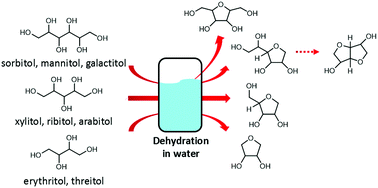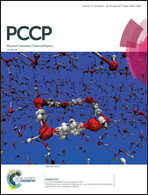Intramolecular dehydration of biomass-derived sugar alcohols in high-temperature water†
Abstract
The intramolecular dehydration of biomass-derived sugar alcohols D-sorbitol, D-mannitol, galactitol, xylitol, ribitol, L-arabitol, erythritol, L-threitol, and DL-threitol was investigated in high-temperature water at 523–573 K without the addition of any acid catalysts. D-Sorbitol and D-mannitol were dehydrated into isosorbide and isomannide, respectively, as dianhydrohexitol products. Galactitol was dehydrated into anhydrogalactitols; however, the anhydrogalactitols could not be dehydrated into dianhydrogalactitol products because of the orientation of the hydroxyl groups at the C-3 and C-6 positions. Pentitols such as xylitol, ribitol, and L-arabitol were dehydrated into anhydropentitols. The dehydration rates of the pentitols containing hydroxyl groups in the trans form, which remained as hydroxyl groups in the product tetrahydrofuran, were larger than those containing hydroxyl groups in the cis form because of the structural hindrance caused by the hydroxyl groups in the cis form during the dehydration process. In the case of the tetritols, the dehydration of erythritol was slower than that of threitol, which could also be explained by the structural hindrance of the hydroxyl groups. The dehydration of L-threitol was faster than that of DL-threitol, which implies that molecular clusters were formed by hydrogen bonding between the sugar alcohols in water, which could be an important factor that affects the dehydration process.



 Please wait while we load your content...
Please wait while we load your content...